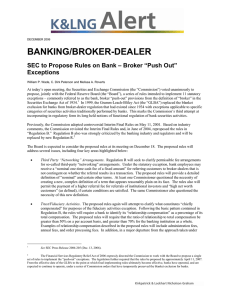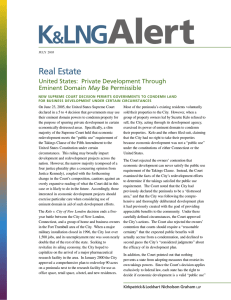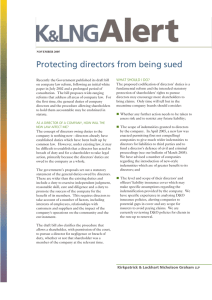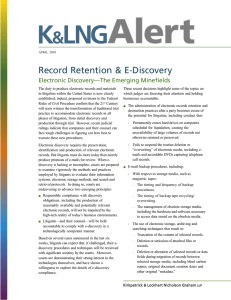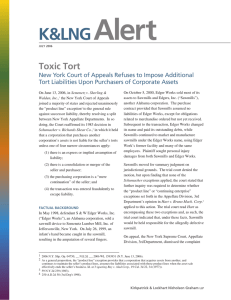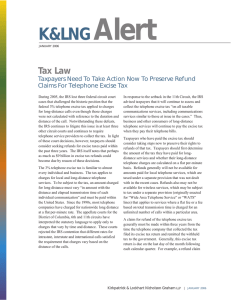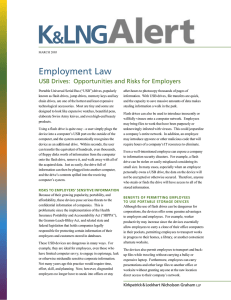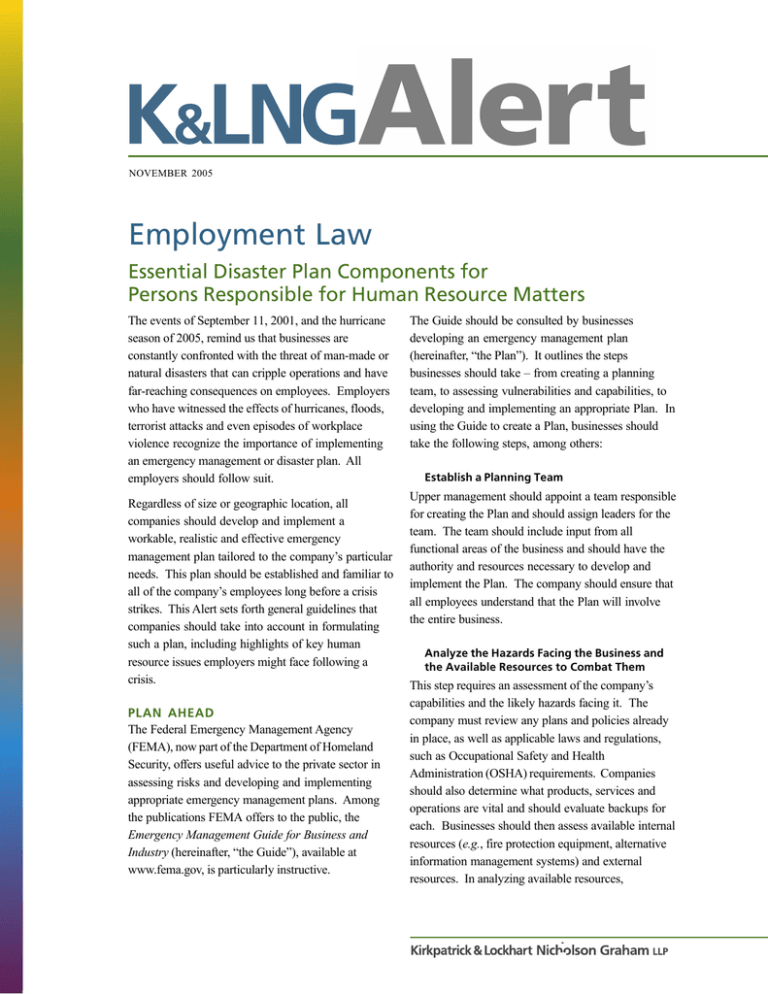
NOVEMBER 2005
Employment Law
Essential Disaster Plan Components for
Persons Responsible for Human Resource Matters
The events of September 11, 2001, and the hurricane
season of 2005, remind us that businesses are
constantly confronted with the threat of man-made or
natural disasters that can cripple operations and have
far-reaching consequences on employees. Employers
who have witnessed the effects of hurricanes, floods,
terrorist attacks and even episodes of workplace
violence recognize the importance of implementing
an emergency management or disaster plan. All
employers should follow suit.
Regardless of size or geographic location, all
companies should develop and implement a
workable, realistic and effective emergency
management plan tailored to the company’s particular
needs. This plan should be established and familiar to
all of the company’s employees long before a crisis
strikes. This Alert sets forth general guidelines that
companies should take into account in formulating
such a plan, including highlights of key human
resource issues employers might face following a
crisis.
PLAN AHEAD
The Federal Emergency Management Agency
(FEMA), now part of the Department of Homeland
Security, offers useful advice to the private sector in
assessing risks and developing and implementing
appropriate emergency management plans. Among
the publications FEMA offers to the public, the
Emergency Management Guide for Business and
Industry (hereinafter, “the Guide”), available at
www.fema.gov, is particularly instructive.
The Guide should be consulted by businesses
developing an emergency management plan
(hereinafter, “the Plan”). It outlines the steps
businesses should take – from creating a planning
team, to assessing vulnerabilities and capabilities, to
developing and implementing an appropriate Plan. In
using the Guide to create a Plan, businesses should
take the following steps, among others:
Establish a Planning Team
Upper management should appoint a team responsible
for creating the Plan and should assign leaders for the
team. The team should include input from all
functional areas of the business and should have the
authority and resources necessary to develop and
implement the Plan. The company should ensure that
all employees understand that the Plan will involve
the entire business.
Analyze the Hazards Facing the Business and
the Available Resources to Combat Them
This step requires an assessment of the company’s
capabilities and the likely hazards facing it. The
company must review any plans and policies already
in place, as well as applicable laws and regulations,
such as Occupational Safety and Health
Administration (OSHA) requirements. Companies
should also determine what products, services and
operations are vital and should evaluate backups for
each. Businesses should then assess available internal
resources (e.g., fire protection equipment, alternative
information management systems) and external
resources. In analyzing available resources,
companies are well advised to reach out to the public
sector and establish meaningful contacts with first
responders (such as police departments, fire
departments and emergency medical services
organizations), as well as second responders who may
be called upon in the event of an emergency (such as
the regional FEMA office, state emergency
management agencies, and the local office of the
Federal Bureau of Investigation) and utility
companies.
Perform an Insurance Audit
Companies should also review insurance policies and
ensure that appropriate coverage is in place.
Businesses should work closely with their insurance
carriers to understand any applicable exclusions or
areas of exposure.
Conduct a Vulnerability Analysis
This step requires a company to examine the hazards
within the company and the community in which the
business is located and consider crises that have
occurred in the past or which may result from the
geographic location of the business or from
technological or human error. Companies should
solicit external input to identify potential hazards,
such as from local emergency management agencies.
Businesses should then determine the likelihood of
facing those hazards and the impact on the business
were they to occur (for instance, if a crisis were to result
in the shutdown of the business, would the company
be in violation of its contractual obligations?). The
company should also assess the available internal and
external resources with which to respond to each
potential crisis. The Guide provides a numeric system
to make this assessment.
Develop the Plan
The Plan should address seven core elements:
direction and control; communication; life safety;
property protection; community outreach; recovery
and restoration; and administration and logistics. A
business must establish deadlines and milestones to
ensure the Plan addresses each of these areas and is
completed in a timely fashion. In drafting the Plan,
businesses must anticipate difficult employment
concerns which must be carefully analyzed well before
a crisis. For instance, in the event of a shutdown of the
2
NOVEMBER 2005
business, will the business offer employees salary
continuation? Crisis counseling?
Emergency response procedures should be outlined in
the Plan with appropriate supporting documentation
(e.g., emergency call lists, building schematics, and
resource lists). The company must coordinate with
government authorities to solicit their input, comply
with any reporting requirements, and address any
logistical concerns. Businesses should then test drafts
of the Plan within the company, such as by engaging
in “tabletop exercises” – conference room meetings
where a hypothetical crisis is presented, and
employees responsible for managing a crisis explain
what they would do at each stage. Such exercises are
helpful in identifying areas of confusion or overlap.
Companies should modify and finalize the Plan in
light of these efforts and then distribute it.
Implement the Plan
Once the Plan is complete, the company must create a
culture of compliance with it. Training and drilling
on the Plan must be planned in advance and
conducted routinely so that the Plan remains viable
and relevant.
Evaluate and Modify the Plan
The Plan is not, and should not become, a static
document. It must be periodically audited, reviewed
and amended so that it remains an accurate, realistic
and lawful outline for the company to follow in an
emergency. Indeed, following the Plan must be
second-nature for it to be effective in a crisis.
A key component to any well drafted Plan will be the
consideration of issues that affect the human capital of
an organization – its employees. Any unique scenario
will involve different issues related to employee rights
and benefits, safety and welfare. As part of the
planning process, however, employers should consider
their existing employment policies and practices and
the legal obligations they might face depending on
the nature and scale of a disaster.
WHAT IF EMPLOYEES CANNOT OR DO
NOT RETURN TO WORK AFTER A CRISIS?
Evaluate Protected Leave Eligibility
Employees who do not return to work immediately
following a disaster may be eligible for some form of
KIRKPATRICK & LOCKHART NICHOLSON GRAHAM LLP
protected leave under state or federal law or under
company policies, including, for example, those set
forth below.
■
Uniformed Services Employment and
Reemployment Rights Act
Protection under this statute for employed members of
the military who are called into active duty also
extends to cover federal emergency workers
dispatched to assist with natural disasters, including
intermittent disaster response appointees upon
activation of the National Disaster Medical System.
■
Family and Medical Leave Act (“FMLA”)
If the Company employs fifty or more people within a
seventy-five mile radius, consider whether employees
are eligible for leave based on their own serious health
condition or the serious health condition of a family
member.
■
Americans With Disabilities Act
An employee who is not eligible for leave under the
FMLA may be eligible for leave as a reasonable
accommodation for a qualifying disability.
Provide Required Benefit Continuation Forms
Evaluate necessary documentation to be provided to
employees.
■
Consolidated Omnibus Budget
Reconciliation Act (“COBRA”)
Employees and their families who lose their health
benefits may have the right to continue group health
benefits provided by their group health plan for
limited periods of time under certain circumstances
such as voluntary or involuntary job loss, reduction in
the number of hours worked, transition between jobs,
death, and other life events. Qualified individuals
who elect to continue coverage under COBRA may be
required to pay the entire premium for coverage up to
102 percent of the cost to the plan. Employees not
entitled to continue group health benefits under
COBRA may, nevertheless, have coverage under
similar state laws.
■
Employees who do not or cannot return to work may
be eligible for final wages, payment for accrued but
unused vacation time, and/or other benefits provided
under company policies or individual contracts
including, among others, commissions, bonuses,
expense reimbursement or severance. If employees
fail to return to work, payments due to them should be
sent to the employee’s last known address.
GOING FORWARD WITH THOSE
WHO WANT TO RETURN TO WORK
Provide for Safety and Welfare
Help create a smooth transition for those employees
returning to work.
■
Occupational Safety and Health Administration
Following a disaster, remain mindful of standards for
workplace safety. Employees may not work if they
have a good faith belief that there is an “imminent
danger” in the workplace that has been reported to a
supervisor, has not been corrected, and cannot be
timely addressed through OSHA’s complaint process.
An “imminent danger” exists where there is a threat of
death or serious physical harm or a reasonable
expectation that toxic substances or other health
hazards are present and that exposure to them will
shorten life or cause substantial reduction in physical
or mental efficiency.
■
Employee Assistance Plan (“EAP”)
If the company has an EAP in place, make sure it is
accessible to those who may need it and remind
employees of the existence and confidential nature of
services available through the EAP.
■
Employee Outreach
Consider establishing policies that allow employees
to donate vacation/sick/personal days to other
employees to assist those who have been affected by a
disaster. Also consider whether the company can set
up a charitable foundation to accept donations from
employees or others to assist affected employees and
their families.
Unemployment
Many state unemployment laws require employers to
provide separated employees with a notice of their
rights to unemployment within a certain time period
following their separation from employment.
3
Honor Obligations to Employees
NOVEMBER 2005
Payroll and Benefit Considerations
Under wage and hour laws, employers are required to
pay nonexempt employees only for hours actually
worked. For exempt employees, however, if the
KIRKPATRICK & LOCKHART NICHOLSON GRAHAM LLP
employee’s exempt status is based in part on the fact
that the employee is salaried, you must not deduct
from the employee’s salary unless it is permissible to
do so under one of the limited exceptions to the Fair
Labor Standards Act. In addition, if you assign an
“exempt” employee to perform “nonexempt” job
duties or responsibilities following a disaster, you may
have to pay overtime.
WHAT HAPPENS IF WE CLOSE OUR
DOORS OR HAVE TO DOWNSIZE?
Worker Adjustment Retraining and
Notification Act (“WARN”)
If a disaster results in either a mass layoff or plant
closing (as defined by WARN), consider applicability
of WARN and possible exceptions, including the
natural disaster exception. If an employer can
demonstrate that the plant closing or mass layoff is a
direct result of the natural disaster, it is excused from
full compliance with the 60-day notice requirement
under WARN. However, if applicable, an employer
must still give such notice as is practicable either
before or after the employment loss. Some
“unnatural” disasters may qualify under the
“unforeseeable business circumstance” exception to
WARN.
Layoff Analysis
Prior to conducting a layoff, consider business
justifications for employee terminations and consider
employees’ status as members of protected categories
and any potential adverse impact of any layoffs. Also
consider whether anyone has recently taken a
protected leave of absence or complained of any
unlawful activity that could form the basis of a claim
for retaliation.
Relocation
Assess feasibility of relocating affected employees to
other offices, providing temporary offsite work space
and/or allowing employees to work remotely.
While this checklist highlights certain issues and
obligations employers may want to consider, it is not
inclusive of all state and federal employment laws that
may become important following a disaster.
You should, therefore, consult with counsel before
taking action in any area that could have legal
consequences.
Wendy A. Berliner
wberliner@klng.com
617.261.3137
Christine Watts Johnston
cjohnston@klng.com
617.261.3138
Michael D. Ricciuti
mricciuti@klng.com
617.951.9094
4 NOVEMBER 2005
KIRKPATRICK & LOCKHART NICHOLSON GRAHAM LLP
If you have questions or would like more information about K&LNG’s Employment
and Labor practice, please contact one of our lawyers listed below:
Boston
Henry T. Goldman
Mark D. Pomfret
617.951.9156
617.261.3147
hgoldman@klng.com
mpomfret@klng.com
Dallas
Jaime Ramón
214.939.4902
jramon@klng.com
Harrisburg
Carleton O. Strouss
717.231.4503
cstrouss@klng.com
London
Paul Callegari
Los Angeles
+44.20.7360.8194
pcallegari@klng.com
Thomas H. Petrides
Paul W. Sweeney, Jr.
310.552.5077
310.552.5055
tpetrides@klng.com
psweeney@klng.com
Miami
April L. Boyer
Carol C. Lumpkin
Michael C. Marsh
305.539.3380
305.539.3323
305.539.3321
aboyer@klng.com
clumpkin@klng.com
mmarsh@klng.com
Newark
Rosemary Alito
Vincent N. Avallone
Marilyn Sneirson
973.848.4022
973.848.4027
973.848.4028
ralito@klng.com
vavallone@klng.com
msneirson@klng.com
New York
Eva M. Ciko
212.536.3905
eciko@klng.com
Palo Alto
Linda L. Usoz
650.798.6702
lusoz@klng.com
Pittsburgh
Stephen M. Olson
Michael A. Pavlick
Hayes C. Stover
412.355.6496
412.355.6275
412.355.6476
solson@klng.com
mpavlick@klng.com
hstover@klng.com
San Francisco
Jonathan M. Cohen
415.249.1029
jcohen@klng.com
Washington
Lawrence C. Lanpher
202.778.9011
llanpher@klng.com
www
w.. k l n g . c o m
BOSTON DALLAS HARRISBURG LONDON LOS ANGELES MIAMI NEWARK NEW YORK PALO ALTO PITTSBURGH SAN FRANCISCO WASHINGTON
n
n
n
n
n
n
n
n
n
n
n
Kirkpatrick & Lockhart Nicholson Graham LLP (K&LNG) has approximately 1,000 lawyers and represents entrepreneurs, growth and middle market companies, capital markets participants,
and leading FORTUNE 100 and FTSE 100 global corporations nationally and internationally.
K&LNG is a combination of two limited liability partnerships, each named Kirkpatrick & Lockhart Nicholson Graham LLP, one qualified in Delaware, U.S.A. and practicing from offices in
Boston, Dallas, Harrisburg, Los Angeles, Miami, Newark, New York, Palo Alto, Pittsburgh, San Francisco and Washington and one incorporated in England practicing from the London office.
This publication/newsletter is for informational purposes and does not contain or convey legal advice. The information herein should not be used or relied upon in regard to any particular
facts or circumstances without first consulting a lawyer.
Data Protection Act 1988 - We may contact you from time to time with information on Kirkpatrick & Lockhart Nicholson Graham LLP seminars and with our regular newsletters, which may be
of interest to you. We will not provide your details to any third parties. Please e-mail cgregory@klng.com if you would prefer not to receive this information.
© 2005 KIRKPATRICK & LOCKHART NICHOLSON GRAHAM LLP. ALL RIGHTS RESERVED.



